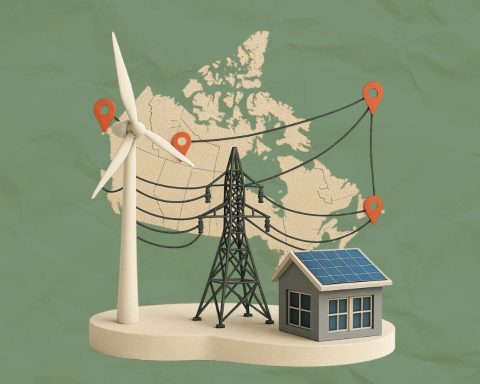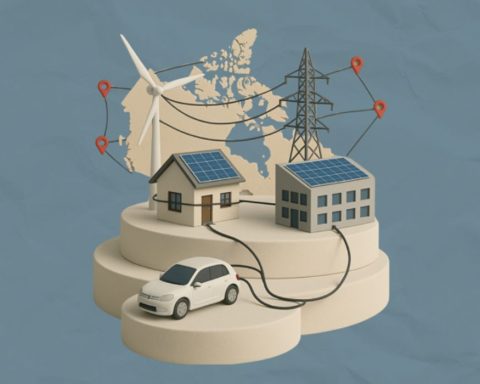Earlier this year, Prime Minister Mark Carney issued a candid appraisal of the demands of our current era: “We will have to do things we haven’t imagined before, at speeds we didn’t think possible.”
That’s true across the globe, as the climate emergency becomes an ever-present danger. And it’s true here, in Canada, as we grapple with setting a path to net-zero that has widespread buy-in because it makes sense and is necessary.
It’s a problem that Corporate Knights has devoted the better part of a year trying to solve. The fruits of that labour are contained in an extensive new analysis from our Climate Dollars project, which lays out the capital investments that will be needed to shift nearly all of Canada’s energy use to electricity and set a realistic path to a zero-emission economy by 2050.
Climate Dollars shows that we can well afford to confront and solve the climate emergency, at less than it would cost to perpetuate the obsolete, polluting, 20th-century energy system that we have today. We can still get it done by the middle of this century. And the solutions on offer will keep us safer in the local climate disasters on the horizon while making Canada stronger and more self-reliant against threats to our sovereignty.
With its extensive modelling of the country’s electricity, buildings and transportation sectors, Climate Dollars represents the next inflection point in the response to the global climate emergency. The analysis asks two basic questions:
• What do we have to do to quickly and effectively address one of the most urgent crises facing humanity?
• What is the gap between the capital investments required to decarbonize Canada’s economy and the dollars now being devoted to that task?
Climate Dollars is an ambitious but achievable road map to transform Canada to a zero-emission economy over the next 25 years, at a cost that is comparable to what households, businesses and financial institutions already devote to capital expenditures each year.
The supply scenario includes upgrading hydroelectric facilities, installing millions of new solar panels, and completing the commitments already made to rebuilding old nuclear plants. But wind energy emerges as the workhorse in any feasible pathway to a zero-emission electricity system in a decarbonized Canada by 2050.
Electricity: Building out the Trans-Canada Transmission Link
The vision of a decarbonized, interconnected, resilient national power system is at the heart of the Climate Dollars analysis. It requires capital investments in solar, wind and storage technologies that average $34.8 billion per year over the next 25 years, in addition to the roughly equal amount of capital needed to electrify the buildings and vehicles.
“The level of investment required is well within the capability of Canadian investors,” says Ralph Torrie, director of research at Corporate Knights, who led the modelling effort. “In fact, in the power sector, capital expenditures have been growing in recent years and are already where we need them to be for decarbonization. The challenge is to shift priorities for that spending to align with the technologies of the new grid.”
The scenario shows Canada nearly doubling its electricity consumption by 2050, from less than 600 to more than 1,000 terawatt-hours (TWh) per year, and meeting that demand with existing hydroelectric resources plus 178 gigawatts of wind power and 50 GW of solar – including 36 GW from utility-scale solar farms and 14 GW from rooftop arrays. Without a national grid, the necessary wind capacity jumps to 261 GW.
This is our fire drill moment, and it will require the motivational equivalent of war.
—Ralph Torrie, director of research, Corporate Knights
The system is brought together by the Trans-Canada Transmission Link, a coast-to-coast, high-voltage DC line that will foster interprovincial trade in electricity to bring down the cost of decarbonization. The link will cost $30 to $40 billion to build, including converter stations in each province, and deliver three to four times that much in cost savings.
The interprovincial transactions along the Trans-Canada Transmission Link will be a win for all provinces, whether they’re buying or selling electricity. The prospect of stable domestic markets will increase the incentive for hydropower-rich Newfoundland and Labrador, Quebec, Manitoba and British Columbia to develop their wind resources. And the easy availability of electrons will help out provinces like Alberta, Saskatchewan and Ontario that will be hard pressed to independently develop all the renewable generation they’ll need to decarbonize their economies by 2050.
Buildings: Heat pumps lead the way
In an electrified energy system, the building stock is converted to use heat pumps for space heating. It will take an all-in effort to phase out fossil-fuel-powered heating and cooling by mid-century in Canada’s residential and commercial buildings, but the required average investment of $14.8 billion per year is just 11.5% of the $129 billion Canadian households and businesses already invest in the existing building stock every year.
Even with the efficiency of heat pumps, all this electricity use for heating creates an annual peak in electricity consumption in early January. It is this winter peak that determines the amount of generating capacity needed, and therefore the amount of capital required to build the system out. An aggressive program of deep energy retrofits could reduce the capital needed to provide for the winter peak by $100 billion, but with current industry costs and business practices, the retrofits would cost five times that much. With its focus on heat pumps, the Climate Dollars modelling defaults to the simplest, least expensive path to reduce greenhouse gas emissions in the midst of a global climate emergency.
Transport: The battery under your hood
Canada’s shift from internal combustion to electric vehicles is already well under way. EV sales are growing exponentially, and drivers can look forward to a clean energy dividend from fuel and maintenance savings of up to $1.2 trillion through 2050, after subtracting the cost of the electricity to run the vehicles.
The Climate Dollars modelling also reveals a powerful opportunity that places the battery under the hood (or maybe the floor) of your electric car at the centre of the plan to bring Canada’s emissions to zero by 2050.
Short-term energy storage is the key to the renewable grid, delivering the flexibility to match the peaks and valleys of intermittent electricity supply with constantly fluctuating demand. In the Climate Dollars scenario, the most affordable way to deliver that reliability is with vehicle-to-grid (V2G) systems that allow EVs to charge when solar and wind are abundant and cheap, then release part of that charge to the grid when demand is highest.
The Climate Dollars modelling places the extra cost to electrify all cars and trucks and build the V2G-supporting charging network at $306 billion, an average of $12 billion per year. The challenge will be to get those cars and trucks on the road soon enough to support a 2050 decarbonization deadline, and to build out the charging network fast enough that it doesn’t become a barrier to EV adoption. The average vehicle stays on the road for 15 years or more, so there is no time to lose in scaling up EVs in Canada. The Climate Dollars decarbonization scenario includes annual investment in this sector that peaks at $17.5 billion in 2035 and then begins to decline as EVs reach and surpass price parity with combustion vehicles.
By mid-century, transportation will become a major electricity-using sector, consuming 150 TWh a year, as much electricity as all of Ontario consumes now. V2G cuts the cost of grid decarbonization in half, power companies save $10,000 per vehicle compared to the higher cost of utility-scale storage, and drivers receive a steady flow of V2G revenue if they choose to share part of their battery capacity with the grid.
The bottom line
The in-depth modelling behind Climate Dollars shows that we can renew local and provincial economies and strengthen the Canadian federation while delivering reliable, affordable energy, every hour of every day of the year. The cost of an effective, comprehensive energy transition is far less than what we are already beginning to pay for the impacts of climate change, across Canada and around the world.
And there’s every reason to believe that taking action at the pace and scale we need will drive down the cost of the energy transition itself as solutions scale up, efficiencies accumulate and unit costs are reduced.
The bottom line? The modelling shows that we can bring the economy to zero emissions at a cost of about $1.5 trillion, or $60 billion per year, largely by reallocating some of the more than $640 billion that private and public investors already pour into capital expenditures every year. Or we can drive that cost up by $100 billion or more if we fail to build the Trans-Canada Transmission Link, choose a more expensive option for electricity storage, or build new nuclear generating capacity that costs $45 to $65 billion more than competing renewable-energy options.
“This is our fire drill moment, and it will require the motivational equivalent of war,” Torrie stresses. “We need to get to the point where we are responding to climate change as an emergency. We need to make smart choices and we need to build quickly, not only to respond to climate change but to secure Canada’s position in the emerging sustainable economy.”
The scenario analysis shows that the cost of the transition can vary by hundreds of billions of dollars depending on whether we make smart choices about east–west connections and how we provide the storage the renewable grid requires. It also shows that expensive, slow measures like new nuclear builds, deep residential retrofits and transit megaprojects drive up the cost of the transition and are less effective than electrification and an integrated, renewables-based grid.
What’s next
As Prime Minister Carney said, speed and imagination are two must-have ingredients for Canada. We won’t succeed by tinkering around the edges of an existing system that needs to be reimagined and rebuilt from the ground up.
That’s why the decisions we make today will determine our path to success or failure – and to succeed, we’ll need to think bigger and more ambitiously than we have in a very long time.
Mitchell Beer is publisher of The Energy Mix, a non-profit community news site and e-digest on climate change, energy and the shift off carbon.
The Weekly Roundup
Get all our stories in one place, every Wednesday at noon EST.







